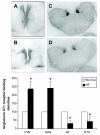Central angiotensin type 1 receptor blockade decreases cardiac but not renal sympathetic nerve activity in heart failure
- PMID: 22311902
- PMCID: PMC3305814
- DOI: 10.1161/HYPERTENSIONAHA.111.181131
Central angiotensin type 1 receptor blockade decreases cardiac but not renal sympathetic nerve activity in heart failure
Abstract
In heart failure (HF), cardiac sympathetic nerve activity (SNA; CSNA) is increased, which has detrimental effects on the heart and promotes arrhythmias and sudden death. There is evidence that the central renin-angiotensin system plays an important role in stimulating renal SNA in HF. Because SNA to individual organs is differentially controlled, we have investigated whether central angiotensin receptor blockade decreases CSNA in HF. We simultaneously recorded CSNA and renal SNA in conscious normal sheep and in sheep with HF induced by rapid ventricular pacing (ejection fraction: <40%). The effect of blockade of central angiotensin type 1 receptors by intracerebroventricular infusion of losartan (1 mg/h for 5 hours) on resting levels and baroreflex control of CSNA and renal SNA were determined. In addition, the levels of angiotensin receptors in central autonomic nuclei were determined using autoradiography. Sheep in HF had a large increase in CSNA (43±2 to 88±3 bursts per 100 heart beats; P<0.05) and heart rate, with no effect on renal SNA. In HF, central infusion of losartan for 5 hours significantly reduced the baseline levels of CSNA (to 69±5 bursts per 100 heart beats) and heart rate. Losartan had no effect in normal animals. In HF, angiotensin receptor levels were increased in the paraventricular nucleus and supraoptic nucleus but reduced in the area postrema and nucleus tractus solitarius. In summary, infusion of losartan reduced the elevated levels of CNSA in an ovine model of HF, indicating that central angiotensin receptors play a critical role in stimulating the increased sympathetic activity to the heart.
Figures




Comment in
-
Sympathetic signatures of cardiovascular disease: a blueprint for development of targeted sympathetic ablation therapies.Hypertension. 2012 Mar;59(3):545-7. doi: 10.1161/HYPERTENSIONAHA.111.182899. Epub 2012 Feb 6. Hypertension. 2012. PMID: 22311900 Free PMC article. No abstract available.
Similar articles
-
Increased cardiac sympathetic nerve activity in ovine heart failure is reduced by lesion of the area postrema, but not lamina terminalis.Basic Res Cardiol. 2018 Aug 3;113(5):35. doi: 10.1007/s00395-018-0695-9. Basic Res Cardiol. 2018. PMID: 30076468
-
Intrathecal Administration of Losartan Reduces Directly Recorded Cardiac Sympathetic Nerve Activity in Ovine Heart Failure.Hypertension. 2019 Oct;74(4):896-902. doi: 10.1161/HYPERTENSIONAHA.119.12937. Epub 2019 Aug 5. Hypertension. 2019. PMID: 31378100
-
Response of cardiac sympathetic nerve activity to intravenous irbesartan in heart failure.Am J Physiol Regul Integr Comp Physiol. 2010 Apr;298(4):R1056-60. doi: 10.1152/ajpregu.00767.2009. Epub 2010 Feb 10. Am J Physiol Regul Integr Comp Physiol. 2010. PMID: 20147604 Free PMC article.
-
Cardiac sympathoexcitation in heart failure.Auton Neurosci. 2013 Apr;175(1-2):76-84. doi: 10.1016/j.autneu.2012.10.017. Epub 2013 Jan 14. Auton Neurosci. 2013. PMID: 23332860 Review.
-
Specific control of sympathetic nerve activity to the mammalian heart and kidney.Exp Physiol. 2010 Jan;95(1):34-40. doi: 10.1113/expphysiol.2008.046342. Epub 2009 Jul 17. Exp Physiol. 2010. PMID: 19617268 Review.
Cited by
-
Influence of sex and sedentary conditions on sympathetic burst characteristics in prepubertal, postpubertal, and young adult rats.J Appl Physiol (1985). 2024 May 1;136(5):1170-1181. doi: 10.1152/japplphysiol.00649.2023. Epub 2024 Mar 21. J Appl Physiol (1985). 2024. PMID: 38511214 Free PMC article.
-
Brain mechanisms of sympathetic activation in heart failure: Roles of the renin‑angiotensin system, nitric oxide and pro‑inflammatory cytokines (Review).Mol Med Rep. 2015 Dec;12(6):7823-9. doi: 10.3892/mmr.2015.4434. Epub 2015 Oct 13. Mol Med Rep. 2015. PMID: 26499491 Free PMC article. Review.
-
Brain angiotensin converting enzyme-2 in central cardiovascular regulation.Clin Sci (Lond). 2020 Oct 16;134(19):2535-2547. doi: 10.1042/CS20200483. Clin Sci (Lond). 2020. PMID: 33016313 Free PMC article. Review.
-
Current Approaches to Quantifying Tonic and Reflex Autonomic Outflows Controlling Cardiovascular Function in Humans and Experimental Animals.Curr Hypertens Rep. 2015 Nov;17(11):84. doi: 10.1007/s11906-015-0597-2. Curr Hypertens Rep. 2015. PMID: 26363932 Review.
-
Effect of global and regional sympathetic blockade on arterial pressure during water deprivation in conscious rats.Am J Physiol Heart Circ Physiol. 2012 Oct 15;303(8):H1022-34. doi: 10.1152/ajpheart.00413.2012. Epub 2012 Aug 17. Am J Physiol Heart Circ Physiol. 2012. PMID: 22904160 Free PMC article.
References
-
- Esler M, Jennings G, Korner P, Willett I, Dudley F, Hasking G, Anderson W, Lambert G. Assessment of human sympathetic nervous system activity from measurements of norepinephrine turnover. Hypertens. 1988;11:3–20. - PubMed
-
- Garg R, Yusuf S, Collaborative Group on ACE Inhibitor Trials Overview of randomized trials of angiotensin-converting enzyme inhibitors on mortality and morbidity in patients with heart failure. JAMA. 1995;273:1450–1456. - PubMed
-
- The CONSENSUS Trial Study Group Effects of enalapril on mortality in severe congestive heart failure. Results of the Cooperative North Scandinavian Enalapril Survival Study (CONSENSUS) New Engl J Med. 1987;316:1429–1435. - PubMed
-
- CIBIS Investigators and Committees A randomized trial of beta-blockade in heart failure. The Cardiac Insufficiency Bisoprolol Study (CIBIS) Circulation. 1994;90:1765–1773. - PubMed
-
- Pfeffer MA, Braunwald E, Moye LA, Basta L, Brown EJ, Jr., Cuddy TE, Davis BR, Geltman EM, Goldman S, Flaker GC, Klein M, Lamas GA, Packer M, Rouleau J, Rouleau JL, Rutherford J, Wertheimer JH, Morton Hawkins, C on, behalf of the SAFE Investigators. The SAVE Investigators Effect of captopril on mortality and morbidity in patients with left ventricular dysfunction after myocardial infarction. Results of the survival and ventricular enlargement trial. New Engl J Med. 1992;327:669–677. - PubMed
Publication types
MeSH terms
Substances
Grants and funding
LinkOut - more resources
Full Text Sources
Medical
Research Materials
Miscellaneous

